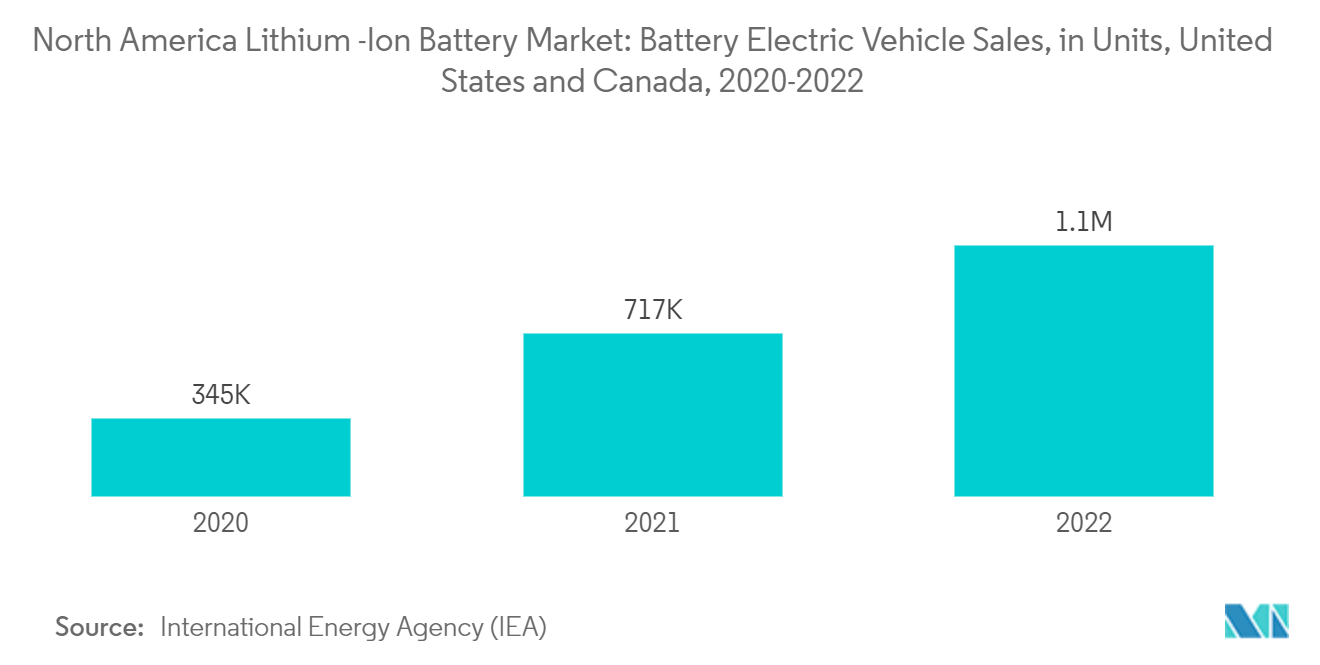Market Trends of North America Lithium-ion Battery Industry
Automotive Batteries Expected to be the Fastest-growing Segment
- Lithium-ion battery systems drive the performance of plug-in hybrid and electric vehicles by meeting OEM requirements for driving range and charging time. Their high energy density, fast recharge capability, and high discharge power make lithium-ion batteries the preferred technology. They outperform lead-based traction batteries in terms of specific energy and weight. As a result, lithium-ion batteries are the most competitive option for total hybrid electric vehicles and electric vehicles.
- Lithium-ion batteries offer a longer lifespan for electric vehicles, which rely on these batteries for power, reducing the frequency of battery replacements. Lithium-ion batteries are considered environmentally friendly compared to other batteries as they do not contain toxic materials like lead or cadmium. It makes them a cleaner and safer choice. Additionally, lithium-ion batteries provide a high power output, which is crucial for electric vehicles that require rapid acceleration and high speeds.
- Moreover, within the electric vehicle battery manufacturing industry, there is a growing popularity of lithium-ion battery prismatic cells. These cells are significantly larger, ranging from 20 to 100 times the size of cylindrical cells. This larger size allows prismatic cells to deliver more power and store greater energy within the same volume. Cylindrical cells, on the other hand, use less material for their casing, which can limit their power and energy storage capabilities.
- Additionally, with the growing sales of electric vehicles, the demand for lithium-ion batteries for the automotive segment is expected to increase significantly during the forecasted period. For instance, according to the International Energy Agency, the sales of electric vehicles in the United States and Canada grew by more than 54% between 2021 and 2022.
- Moreover, in 2022, General Motors & Ford, and American companies announced their targeted strategy to manufacture and sell EVs. General Motors declared its target to manufacture 30 EV models and set up a Battery Electric Vehicle (BEV) production capacity of 1 million units in North America by 2025, plus carbon neutrality in 2040. In comparison, Ford declared its target of One-third of sales to be fully electric by 2026 and 50% by 2030, with all-electric sales in Europe by 2030. It will drive the need for lithium-ion batteries in North America.
- In February 2023, NanoGraf's latest advancement in deploying silicon anodes is positioned to enhance the energy and power densities of forthcoming lithium-ion batteries. This breakthrough technology effectively addresses the challenges associated with silicon anodes.
- Therefore, the increasing shift towards electric vehicles is expected to drive the North America Lithium-ion Battery Market during the forecast period.

The United States Expected to Dominate the Market
- The United States is one of the pioneers in research and innovation in the global battery market. The region also remains one of the largest consumers of batteries, i.e., both primary and secondary battery types. It is owing to increased electric vehicle deployment, spending on consumer electronics, and consumer and manufacturing activities.
- The United States includes a well-established manufacturing infrastructure for lithium-ion batteries, a significant number of battery manufacturers, and research and development facilities focused on battery technologies. This infrastructure gives the United States a competitive edge regarding production capacity and technological advancements.
- For instance, in October 2022, Honda announced its plans to manufacture lithium-ion batteries in the United States, making it the latest car company to do so. In a joint venture with LG Energy Solutions, Honda aims to supply the North American market with "pouch type" batteries designed to power electric vehicles under its Honda and Acura brands. While the exact location of the USD 4.4 billion factory is not disclosed, the joint venture is expected to commence by the end of this year, pending regulatory approval. Construction is planned to begin in early 2023 to achieve mass production of advanced lithium-ion battery cells by the end of 2025.
- Moreover, the United States holds a large market for electric vehicles driven by government incentives, environmental regulations, and consumer demand for cleaner transportation options. The increasing adoption of EVs fuels the demand for lithium-ion batteries, giving the United States an advantage in the market.
- The new policies mandate that projects receiving federal support, including the USD 200 million in the agency's 2022 budget to support battery technology, must manufacture their products within the United States. It also applies to the USD 17 billion issued by the lending authority under DOE's Advanced Technology Vehicles Manufacturing Loan Program.
- According to the International Energy Agency, the country's electric vehicle sales were around 990000 compared to 630000, registering a growth rate of more than 57% between 2022 and 2021.
- Moreover, as of 2022, the cumulative large-scale battery storage capacity was around 22,385.1 megawatt-hours (MWh), which was approximately 80% more than in 2021, as per the United States Energy Information Administration. In the United States, the California Independent System Operator (CAISO) and Electric Reliability Council of Texas (ERCOT) include most of the large-scale battery storage capacity additions. In 2022, CAISO had 7561.3 MWh or 34 % share, and ERCOT had 1684.4 MWh capacity or 7.5% share in the country’s overall installed capacity.
- Further, the country's EV manufacturers are undertaking further initiatives to cater to the rising demand. Thirteen new battery cell giga-factories are expected to come online in the United States by 2025. These giga-factories are being developed by various automobile manufacturers, like Ford Motor Company and General Motors Company, to support their electric vehicle manufacturing and sales.
- Therefore, the country is likely the dominant player in the North American lithium-ion battery market, supported by increasing urbanization and consumer spending. These are expected to ramp up the demand for technically advanced devices and vehicles due to the benefits provided by the same. Consecutively, this is expected to boost the usage of batteries.


